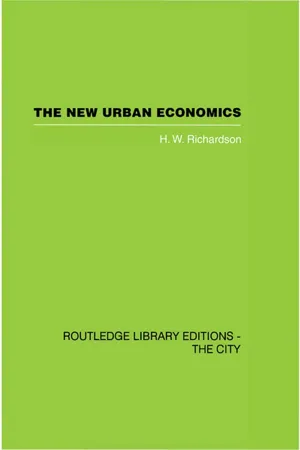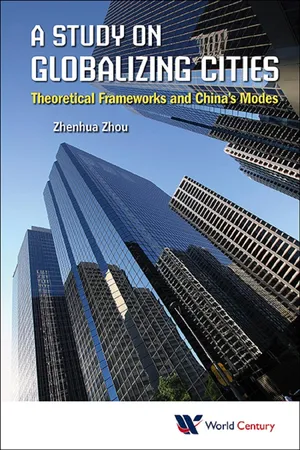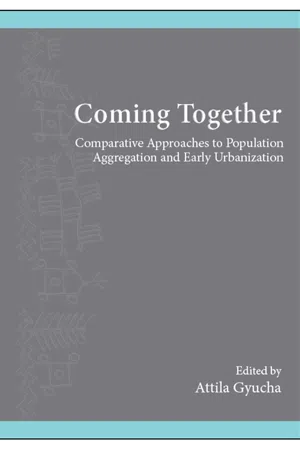Geography
Multiple Nuclei Model
The Multiple Nuclei Model is a theory in urban geography that suggests cities develop with multiple centers of activity, rather than a single central business district. It proposes that different activities and land uses cluster around various nodes or nuclei within a city, each with its own unique characteristics and functions. This model helps explain the complex and diverse spatial patterns found in urban areas.
Written by Perlego with AI-assistance
Related key terms
3 Key excerpts on "Multiple Nuclei Model"
- eBook - ePub
The New Urban Economics
And Alternatives
- H.W. Richardson(Author)
- 2013(Publication Date)
- Routledge(Publisher)
6 The multicentric cityIntroduction
The dominance of the assumption of a monocentric city in NUE models is easy to understand. It permits analytical solutions by making the mathematics tractable. The concentration of jobs at one location, and the associated assumption that the workplace is centrally located, allows the two dimensions of space to be compressed into one. This disregard of nonwork trips (either by assuming that shopping trips are part of the journey-to-work or by assuming that shops are distributed spatially in the same way as population) enables the allocation of expenditures between transport and other items in the household budget to be determined relatively easily, as well as allowing a simple treatment of the demand for land for transport purposes compared with competing land uses. Once the assumption of a single workplace is dropped, an early extension is to allow specialization of function among a hierarchy of centres, and this means relaxing the assumption of a composite consumption good, which is a considerable analytical convenience. Once multiple goods are introduced, with specialization among centres, the model has to accommodate intrametropolitan freight shipments as well as deal with a much more complex commuting pattern. It may no longer be possible to obtain determinate solutions, and rent and density surfaces may cease to be smooth and differentiable. In these circumstances, it is hardly surprising that NUE modellers have preferred to compromise with reality and work with the abstraction of the mono centric city.It is not possible at this stage to develop a satisfactory model of multicentric urban structures. Spatial concentrations in cities are usually explained in terms of the benefits of agglomeration economies, but knowledge of how these forces operate remains very limited. Accordingly only a few eclectic observations as to how such a model might eventually be developed will be offered here. No attempt will be made to suggest solutions to the problem of mathematical intractability. - eBook - ePub
Study On Globalizing Cities, A: Theoretical Frameworks And China's Modes
Theoretical Frameworks and China's Modes
- Zhenhua Zhou(Author)
- 2014(Publication Date)
- WCPC(Publisher)
In the development process of theories, after Burgess and the others put forward the theories of the urban spatial structure with mono-center, as early as in 1945, Harris and Ullman (1945) put forward the theories of urban spatial structure of multicore. To them, there are four factors influencing the distribution of urban events, namely, some events need a few areas located in the city center with proper facilities, some events needs the bordering areas, some events tends to have resistant or negative effects to other events, and some events have to locate in inappropriate places because they cannot afford to the expensive cost of the ideal ones. With the interaction of the four factors, the influence of history, or the features of some areas, the distribution of regional spaces formed their respective cores. But this theory attaches less importance to the functions between the multicores, especially to the analysis on the differences between the cores and the orientation of the overall development of the city. In 1981, Muller broadened the theory of multicores, and put forward a new mode of spatial structure of the metropolis, as an urban spatial structure composed of the central city, inner suburbs, outside suburbs, and city edges. Among them, outside suburbs form several small cities. Therefore, compared to the mode of multicores, this mode can be named the mode of multicenters.In such a case, the population of the central city moves to the suburbs, including the main important industry sectors, and there is a tendency to gather in different centers of the suburbs. At the beginning, the sectors are mainly the manufacturing industry, followed by logistics, retailing, and service; facilities such as culture, education, sanitation, and entertainment. As more and more companies and financial institutions appeared in suburbs, the various kinds of economic events are distributed in different centers of the suburbs. So, the suburbs will have more complete functions and thus form the new city district closely related to the original central district of the city, and an urban spatial structure with multicenters is shaped. Of course, the emergence of urban multicenters is based on the connection of track transportation, which is distributed in the areas along the main lines of transportation. This fast track transportation network meets the needs of road traffic, information transmission, food, and entertainment of city life, and connects the different centers to an organic integrity.As a globalizing city, it is urgent to adapt to the changes of this urban spatial structure. The reasons are obvious: one of them is that a globalizing city has to face and experience the new breakthroughs of science technologies, and the rising service sectors has replaced the traditional industries and become the mainstay industry, a global network system based on modern information technology has formed and changed, making it a core question to match the special functions of main nodal points to the urban spatial structure with multicenters. - eBook - ePub
SUNY series, The Institute for European and Mediterranean Archaeology Distinguished Monograph Series
Comparative Approaches to Population Aggregation and Early Urbanization
- Attila Gyucha, Attila Gyucha(Authors)
- 2019(Publication Date)
- SUNY Press(Publisher)
Major anthropological questions related to population aggregations in specific regions and periods include what pressures or opportunities triggered these processes and how agglomerations unfolded. In respect to these matters, Adler, van Pool, and Leonard (1996) have provided one of the most exhaustive overviews in the archaeological literature. The authors discussed push and pull models for aggregation and abandonment among ancestral Pueblo populations, considering potential exogenous and endogenous causal agents. Social scientists studying contemporary urban dynamics commonly view these same questions from the perspective of the participant groups and individuals, exploring the costs and benefits of aggregation (e.g., Abu-Lughod 1969; Body-Gendrot and Martiniello 2000; Brown and Wardwell 1980). Although the spectrum of potential causal agents that contributed to population aggregation in various past societies is broad, most of the relevant studies conclude that models for population aggregation and dispersal must consider the interplay of multiple push and pull factors (Algaze 2008; Kelly and Brown 2014; Leonard and Reed 1993; Smith 2014). Nevertheless, one of the common grounds that many scholars share with regard to both past and present societies is that the increased level and low cost of a large number of interactions is a major driver, as well as a benefit, of population nucleation (Gaspar and Glaeser 1998; Martín and Herrera 2014; Ortman et al. 2014; Tilly 1974; see also Smith this volume). The introduction of more regular and more intensive interactions is an adaptive, and productive, response to social, economic, and political challenges. These challenges may be associated with numerous endogenous and exogenous forces in a society, such as changes in trade networks, intensification of conflicts, an elevated level of social stress, or environmental pressures. This scenario holds equally for demographic and political centers that emerged through bottom-up and top-down mechanisms (for the former, see Birch, for the latter, see Kaiser and Pullen in this volume).In this book, a particular stress is placed upon the study of how
Index pages curate the most relevant extracts from our library of academic textbooks. They’ve been created using an in-house natural language model (NLM), each adding context and meaning to key research topics.


